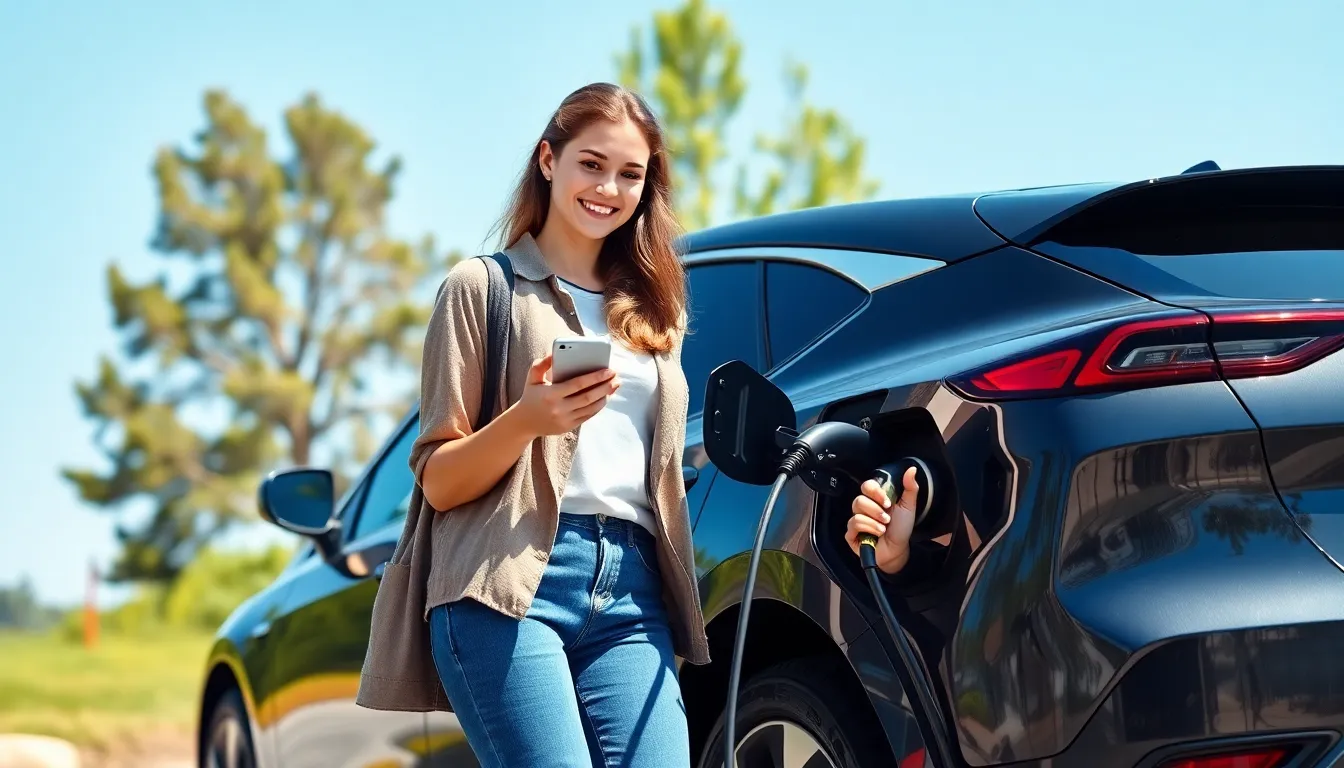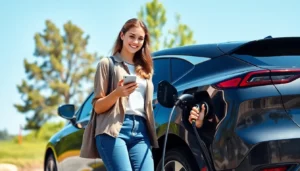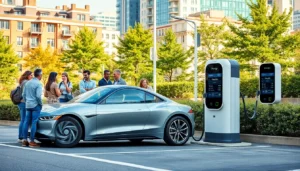Electric vehicles are zooming into the fast lane of the automotive world, and it’s not just because they’re silent and sneaky. With growing concerns about climate change and skyrocketing gas prices, more people are trading in their gas guzzlers for eco-friendly rides. It’s like the coolest club in town, and everyone wants in on the action.
Table of Contents
ToggleOverview Of EV Adoption Trends
Electric vehicles (EVs) continue to gain traction in the market, reflecting significant changes in consumer behavior. A report from the International Energy Agency (IEA) indicated a 60% increase in global EV sales in 2022 compared to the previous year. Notably, over 10 million electric cars were sold worldwide, marking an important milestone for the sector.
Government initiatives play a crucial role in encouraging EV adoption. Many regions offer tax incentives, rebates, and grants to incentivize consumers to purchase electric cars. In addition, expanding charging infrastructure supports this transition by alleviating range anxiety among potential buyers. By 2025, experts predict that the number of charging stations will reach over 1 million in the United States alone.
Consumer preferences are shifting, with awareness of environmental issues driving demand for sustainable transportation. Approximately 60% of consumers express interest in purchasing an EV as their next vehicle. Many now view electric vehicles as a viable choice, aligning with broader societal goals of reducing carbon footprints.
Automakers are responding to this growing demand by increasing their EV offerings. Major manufacturers, including Ford and General Motors, announced substantial investments into EV production with plans to roll out numerous new models over the next few years. Such expansions will likely enhance competition and variety within the market, resulting in more affordable options for consumers.
The trend of EV adoption signifies not just a shift in vehicle preferences but also an evolution in transportation ethics. As sustainability becomes more critical, the automotive landscape will continue to transform, driven by innovations and changing consumer values.
Factors Influencing EV Adoption
Several key factors contribute to the growing adoption of electric vehicles.
Government Policies
Government initiatives significantly influence EV adoption. Tax incentives and rebates motivate consumers to switch from gas-powered to electric cars. For instance, the U.S. federal tax credit for electric vehicle purchases can reach up to $7,500, making EVs more financially appealing. Expanding charging infrastructure also supports this transition. By 2025, the U.S. will see over 1 million charging stations, addressing range anxiety among potential buyers. Local and state governments are also implementing stricter emissions regulations. These policies encourage manufacturers to invest in electric options, driving further growth in the market.
Consumer Awareness
Consumer awareness plays a crucial role in EV adoption. More individuals are recognizing the environmental benefits of electric vehicles, with approximately 60% expressing interest in EVs for their next vehicle purchase. Information campaigns by environmental organizations and automakers help educate the public on the advantages of EV ownership. Social media also serves as a platform for sharing user experiences and knowledge, increasing overall interest. As awareness grows, so do consumer expectations for greener technology. The automotive industry’s shift reflects these changing preferences, leading to a broader selection of eco-friendly options.
Regional Variations In EV Adoption
Regional dynamics significantly influence electric vehicle (EV) adoption across the globe. Factors such as government policies, infrastructure development, and consumer preferences shape these variations.
North America
In North America, EV adoption is rapidly gaining momentum. The U.S. sold over 750,000 electric cars in 2022, reflecting a 70% increase from the previous year. Consumers benefit from tax credits up to $7,500, which enhance affordability. States like California lead with ambitious emission standards and robust charging networks, making EV ownership more practical. Less populated areas still face challenges with infrastructure, impacting adoption rates. Many automakers are shifting production to meet rising demand, focusing on versatile EV models. Overall, North America’s market continues to evolve with increasing consumer awareness and supportive policies.
Europe
European nations demonstrate substantial leadership in EV adoption. Norway tops the chart, with nearly 54% of new car sales being electric in 2022. Incentives such as favorable tax structures and extensive charging stations drive this trend across the continent. Countries like Germany and the Netherlands are investing heavily in green technology, pushing for an ambitious target of a significant reduction in greenhouse gas emissions. Additionally, stringent emissions regulations compel manufacturers to innovate rapidly, expanding their EV portfolios. Europe’s commitment to sustainability positions it as a crucial player in the global electric vehicle landscape.
Asia
Asia presents a mixed picture regarding EV adoption, influenced by diverse market dynamics. China stands out as the largest market for electric vehicles, with sales surpassing 6 million units in 2022. Government subsidies and a sprawling charging infrastructure fuel the rapid growth. Japan and South Korea are also investing in EV technology, establishing ambitious targets for electric vehicle sales. Urban areas often enjoy better infrastructure, while rural regions lag due to limited charging options. Automakers in Asia are prioritizing innovation, focusing on battery technology and sustainability. This regional landscape is vital for understanding global EV trends.
Challenges To EV Adoption
Numerous challenges hinder the rapid adoption of electric vehicles (EVs). Addressing key issues like infrastructure limitations and battery technology remains crucial for expanding EV accessibility.
Infrastructure Limitations
Charging infrastructure poses significant challenges for widespread EV adoption. A lack of charging stations creates barriers for potential buyers, as many fear running out of battery power—often referred to as range anxiety. In 2022, over 750,000 electric cars sold in the U.S. highlighted the urgent need for more charging points. By 2025, the expected increase to over 1 million charging stations is essential for alleviating this concern. Additionally, urban areas often lack enough access to charging facilities, making it difficult for consumers to switch from traditional vehicles. Addressing these infrastructure gaps can significantly enhance EV usability and convenience.
Battery Technology
Battery technology plays a critical role in the growth of electric vehicles. Current batteries face limitations, such as charging time and energy density. Many consumers express concerns about how long it takes to charge an EV compared to refueling traditional gas-powered vehicles. Advancements in battery technology are vital, with developments focused on increasing range and reducing charging times. Lithium-ion batteries dominate the market, yet ongoing research aims to enhance performance and longevity. As manufacturers invest in next-generation battery technologies, the prospect of more efficient, faster charging solutions could drive increased EV adoption.
Future Projections Of EV Adoption Trends
Future projections indicate sustained growth in electric vehicle (EV) adoption across global markets. By 2025, EV sales could double, with expectations of surpassing 20 million units sold annually. Continued government support remains crucial, as tax incentives, which can reach $7,500, significantly motivate consumer purchases.
Charging infrastructure will also expand rapidly. The U.S. expects to have over 1 million charging stations by 2025, greatly reducing range anxiety for consumers. Increased accessibility aligns with the growing consumer preference for sustainability, with nearly 60% indicating interest in choosing EVs for their next vehicle.
EV manufacturers are responding aggressively to this demand. Automakers like Ford and General Motors plan to launch multiple new models within the next few years, enhancing consumer choice in the market. Investment in EV technology is expected to increase, driven by the recognition of long-term cost savings associated with electric transportation.
Regional dynamics play an essential role in these trends. California leads in EV adoption rates, thanks to its progressive emissions standards and robust charging network. Norway continues to set a standard for Europe as the highest seller of EVs per capita, supported by effective tax policies and infrastructure. In Asia, China remains dominant in the EV space, bolstered by government subsidies that promote significant vehicle sales.
Challenges will still need to be addressed. Infrastructure limitations, particularly in rural areas, hinder adoption rates significantly. Furthermore, battery technology advancements are critical, aiming to provide faster charging solutions and higher energy densities. The ongoing research on innovative battery solutions is likely to play a pivotal role in shaping the future landscape of EVs.
Conclusion
The momentum behind electric vehicle adoption is undeniable and continues to reshape the automotive landscape. As governments and consumers prioritize sustainability the transition to EVs is becoming increasingly mainstream. With significant investments from automakers and the expansion of charging infrastructure the future looks promising.
Challenges remain but the ongoing advancements in battery technology and supportive policies will likely address these concerns. By fostering a culture of eco-consciousness and enhancing accessibility the automotive industry is poised for a transformative shift. The next few years will be crucial in determining how quickly and effectively these trends materialize globally.










